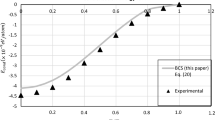Abstract
A novel mechanism of superconductivity is suggested in materials with variable valence. The pairing of the conduction electrons is caused by their interaction with the virtual excitations of the dynamical short-range order, excitations describing the state of the ion subsystem, which exhibit a dual valence. An evaluation of the coupling constant of the electrons with these excitations λcon and of the transition temperature to the superconducting state Tc showed that λcon ∿ 100, Tc ∿ 100 K.
Similar content being viewed by others
Literature cited
C. W. Chu, P. H. Hor, R. L. Meng, et al., Phys. Rev. Lett.,58, 405 (1987).
R. J. Cava, R. B. Van Dover, B. Batlog, and E. A. Reitman, Phys. Rev. Lett.,58, 408 (1987).
P. H. Hor, R. L. Meng, L. Gao, et al., Phys. Rev. Lett.,58, 908 (1987).
P. H. Hor, L. Gao, R. L. Meng, et al., Phys. Rev. Lett.,58, 911 (1987).
F. S. Pazavi, F. P. Koffyberg, and B. M. Mitrovic, Phys. Rev.,B35, 5323 (1987).
A. R. Moodenlaugh, M. Suenaga, T. Asano, et al., Phys. Rev. Lett.,58, 1885 (1987).
D. W. Murphy, S. Sunschine, R. B. Van Dover, et al., Phys. Rev. Lett.,58, 1887 (1987).
P. H. Hor, R. L. Meng, Y. Q. Wang, et al., Phys. Rev. Lett.,58, 1891 (1987).
G. Bednorz and K. A. Müller, Z. Phys.,64B, 189 (1987).
J. M. Tarascon, L. H. Green, and W. R. McKinnon, Science,235, 1373 (1987).
D. U. Gubser, R. A. Hein, and S. H. Lawrence, Phys. Rev.,B35, 5330 (1987).
V. E. Egorushkin and A. I. Murzashev, Fiz. Tverd. Tela,27, 3526 (1985).
S. V. Vonsovskii, Yu. A. Izyumov, and É. Z. Kurmaev, Superconductivity of Transition Metals, Their Alloys and Compounds [in Russian], Nauka, Moscow (1977).
V. E. Egorushkin and N. V. Melnikova, J. Phys. F.,17, 1379 (1987).
Khan Tsui-in, Private Communication.
V. R. Galakhov, B. N. Goshitskii, et al., Fiz. Met. Metalloved.,63, 829 (1987).
P. B. Allen and R. C. Dynes, Phys. Rev.,B12, 905 (1975).
V. E. Egorushkin and R. A. Khon, Electronic Theory of the Transition Metal Alloys [in Russian], Nauka, Moscow (1985), p. 180.
Author information
Authors and Affiliations
Additional information
Translated from Izvestiya Vysshikh Uchebnykh Zavedenii, Fizika, No. 12, pp. 33–35, December, 1987.
Rights and permissions
About this article
Cite this article
Egorushkin, V.E., Murzashev, A.I. Mechanism of superconductivity in metal-oxide compounds. Soviet Physics Journal 30, 1026–1028 (1987). https://doi.org/10.1007/BF00897914
Received:
Issue Date:
DOI: https://doi.org/10.1007/BF00897914



